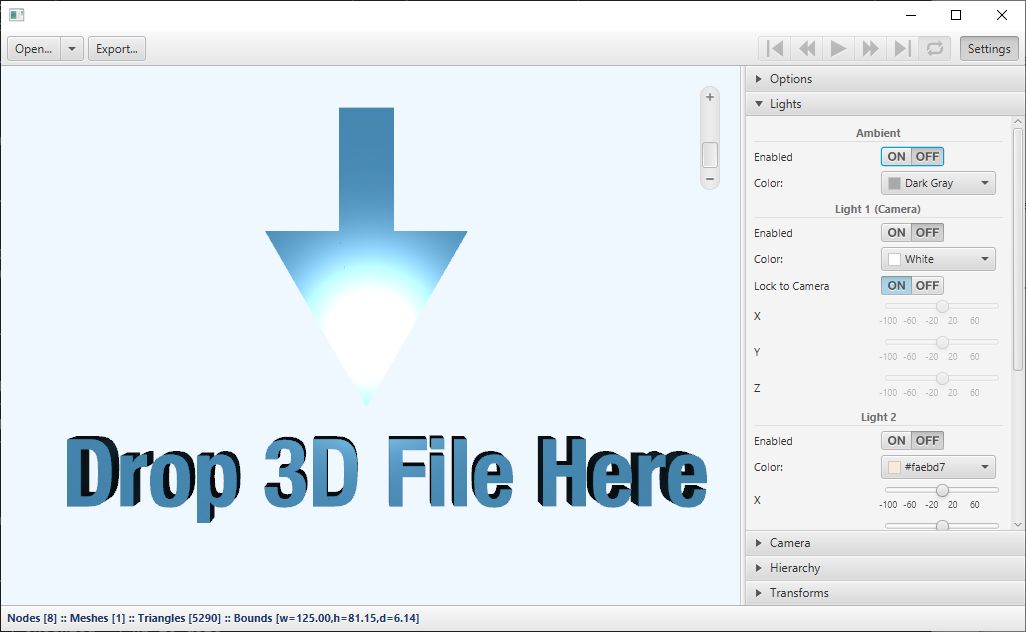This 3DViewer project is a sample JavaFX application extracted from openjdk/jfx/apps/samples/3DViewer.
Description for 3DViewer as excerpted from openjdk/jfx/apps/samples/samples_readme.txt:
3DViewer is a sample application that allows the user to navigate and examine a 3D scene with a mouse or a trackpad. 3DViewer has importers for a subset of the features in OBJ and Maya files. The ability to import animation is also provided for Maya files. (Note that in the case of Maya files, construction history should be deleted on all the objects when saving as a Maya file.) 3DViewer also has the ability to export the contents of the scene as Java or FXML files.
Screenshot of the 3DViewer application:
An excellent overview of this 3DViewer application is described in 3DViewer: Better 3D for JavaFX by Christoph Nahr.
The 3D model code in this application is used as a library dependency to the beautiful RubikFX, a Rubik's Cube 3D simulator by José Pereda.
In this fork, the original Gradle build
script
is updated to build a stand-alone Viewer3D application and/or library, for Java/JavaFX 11+.
The name is changed from the default 3DViewer to Viewer3D, to avoid the following error
at runtime when the jar file happens to be on the module path:
Error occurred during initialization of boot layer
java.lang.module.FindException: Unable to derive module descriptor for lib/3DViewer.jar
Caused by: java.lang.IllegalArgumentException: 3DViewer: Invalid module name: '3DViewer' is not a Java identifier
A Maven build script is also added to this fork.
To build and run the application, execute the Gradle run task:
gradlew run
By default JavaFX 3D will use GPU hardware acceleration for rendering. If hardware acceleration
is not available, i.e. the Viewer3D application shows an empty window, the software acceleration
feature can be used instead (but slow!) by setting the prism.forceGPU system property to true:
gradlew run -Dprism.forceGPU=true
To create an executable uber jar which includes all dependencies for current OS platform:
gradlew uberJar
and the resulting platform-specific Viewer3D-1.0.0-SNAPSHOT-no-deps-<platform>.jar file
should be created in build/libs, and can be executed directly with the java command
(e.g. in Linux):
java -jar build/libs/Viewer3D-1.0.0-SNAPSHOT-no-deps-linux.jar
(or if building on a Windows machine:
java -jar build\libs\Viewer3D-1.0.0-SNAPSHOT-no-deps-win.jar
)
To produce a jlink image
of the Viewer3D application for the current platform, execute the jlink task:
gradlew jlink
The resulting jlink image is in the folder:
build/image
which can then be executed directly, for example in Linux:
./build/image/bin/Viewer3D
(or if building on a Windows machine:
build\image\bin\Viewer3D.bat
)
To build and run the application, execute the Maven javafx:run command:
mvnw javafx:run
By default JavaFX 3D will use GPU hardware acceleration for rendering. If hardware acceleration
is not available, i.e. the Viewer3D application shows an empty window, the software acceleration
feature can be used instead (but slow!) by setting the prism.forceGPU system property to true:
mvnw javafx:run -Dprism.forceGPU=true
To create an executable uber jar which includes all dependencies for current OS platform:
mvnw package
and the resulting platform-specific Viewer3D-1.0.0-SNAPSHOT-no-deps-<platform>.jar file
should be created in target folder, and can be executed directly with the java command
(e.g. in Linux):
java -jar target/Viewer3D-1.0.0-SNAPSHOT-no-deps-linux.jar
(or if building on a Windows machine:
java -jar target\Viewer3D-1.0.0-SNAPSHOT-no-deps-win.jar
)
To produce a jlink image
of the Viewer3D application for the current platform, execute the Maven javafx:jlink command:
mvnw javafx:jlink
The resulting jlink image is in the folder:
target/image
which can then be executed directly, for example in Linux:
./target/image/bin/Viewer3D
(or if building on a Windows machine:
target\image\bin\Viewer3D.bat
)
The project can be imported as-is to any IDE such as Eclipse, IntelliJ IDEA, etc., which understands a Gradle/Maven project structure.
